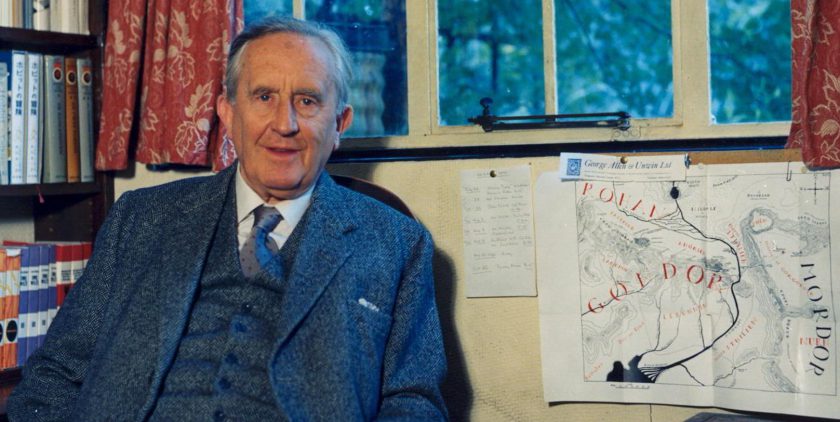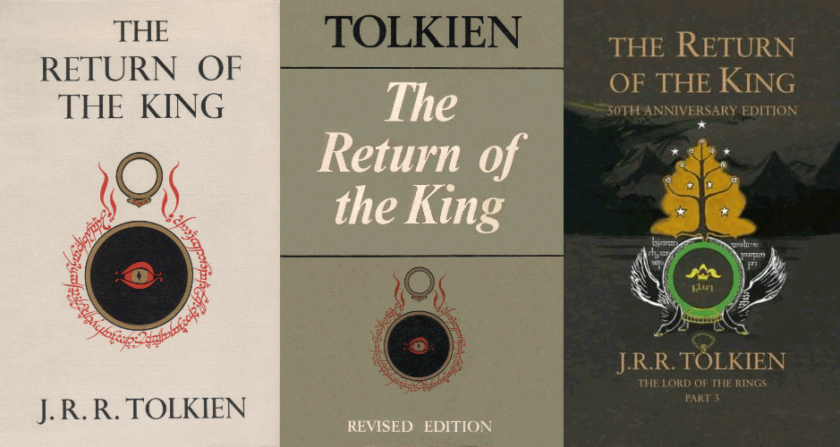
As an author, J.R.R. Tolkien remains one of the most popular writers in the world, with book sales in the 250-300 million range and earning a position where he is widely regarded as the father of modern fantasy. Those book sales have not only touched millions of people the world over – and led to the creation of this Society – but spawned two blockbuster film trilogies which caused Forbes to declare Tolkien as the third highest-earning “dead celebrity” behind Michael Jackson and Elvis Presley.
Tolkien’s popularity isn’t just measured in sales and money, though. His significance has been recognised by the public the world over; a poll by the BBC declared The Lord of the Rings the nation’s favourite book, whilst Amazon customers voted The Lord of the Rings the “book of the millennium”. Anyone who has seen The Big Bang Theory will know how ubiquitous Gandalf, Frodo, Gollum and the One Ring now are in popular culture, and even the Oxford English Dictionary includes “hobbit“, “eucatastrophe” and “Tolkienesque” as words that have now entered the general lexicon.
Not just an author: a creator
Entering the Oxford English Dictionary is not a casual occurrence for writers, and in itself signifies that Tolkien himself is a different type of author. As an academic in English language at the University of Oxford, even from a young age Tolkien demonstrates a deep interest and passion for mythology. Having read and studied Norse, Finnish, Celtic, British and Greek mythology, amongst others, he began to appreciate that those myths that are still with us are steeped in a historical pedigree and depth beyond simply the tale as written.
Tolkien recognised that to create a believable world, he had to fill it with its own geography, history, languages, genealogies, calendars, and peoples. Creating this all-encompassing and consistent world, he used the word “subcreation”. He himself, was the subcreator – creating a secondary world that was thorough, impressive and immersive. The mythological underpinning to Middle-earth was called by Tolkien his “legendarium”, which he filled with a thorough history going back to the creation of the world, an entirely new continent of Middle-earth in which to base the stories, and the races of Elves, Men, Hobbits, Dwarves, Wizards, Orcs, Ents, Trolls and the like who all have distinct cultures. And, to cap it all, Tolkien invented his own languages to go with them, and then his own alphabets in which to write those languages.
It is this depth to Tolkien’s creation that creates a seductively immersive world in which readers can visit. The maps in the books help to make that world a little more “tangible”, as do the usage of Elvish languages and frequent references to other tales. As you read more Tolkien you begin to appreciate just quite how deep these tales are. Casual references in The Lord of the Rings to characters such as Eärendil, Lúthien and Túrin turn out to be whole tales in their own right (with Lúthien set to be appear in the forthcoming publication Beren and Lúthien).
Reading more Tolkien only makes the reader more hungry for more, and more astonished at the author’s ability. Balin and Bilbo feature in both The Hobbit and The Lord of the Rings; Galadriel and Sauron feature in The Silmarillion and The Lord of the Rings, whilst Gandalf and Elrond appear in all three stories. At first it may seem that Tolkien has created a superficial fantasy story, but in fact he has created a fully-imagined world. This fully-imagined world with depth of thought enchants the reader in a web of stories that is as profoundly captivating as it is impressively mind-blowing. It is no wonder, then, that Tolkien is amazingly popular.
Too many characters?
When Tolkien’s sub-creation properly hit bookshelves in 1954 the world immediately took notice. Since that point many other successful fantasy authors have followed in Tolkien’s footsteps with histories, geographies, languages and cultures as the foundations of their stories. J.K. Rowling’s Harry Potter stories are an example, but others include George R.R. Martin’s Westeros, Ursula Le Guin’s Earthsea, Christopher Paolini’s Alagaësia in his Inheritance Cycle, and Terry Pratchett’s Discworld. All of these authors have recognised that Tolkien has laid down a successful template for a popular fantasy series.
So far only concerns the world Tolkien created. But Tolkien filled that world many humanoid races – good and evil – across the peoples, places and cultures of Middle-earth. Each race and culture has a distinctive feel, personality and customs, with their own individual histories and stories which are interwoven within the rest of Middle-earth. These peoples of Middle-earth have their own motivations and agendas, their own hopes, and their own pains.
And within those peoples are the individual characters. Tolkien is an easy target for the claim “There are too many characters – it’s confusing!”, but this is to miss the point. Those varied characters are all unique and distinct, only a casual comparison of the personalities of Frodo and Pippin, or Aragorn and Denethor reveals that Tolkien put as much thought into each individual character as he did to his maps. The characters create a reality to the story that is consistent with the length of the quests undertaken. It would hardly stack up to scrutiny if Tolkien had created a mythology and filled it with only a couple of major characters.
But, there is more to it than that. The characters Tolkien created each demonstrate different aspects of the human condition, and as such they are all relatable. This is one of the key planks of Tolkien’s popularity. The plethora of characters means that whoever reads the stories there is always at least one character “for you”, the character who you feel is written for you and whose struggles you feel you can relate to. Whether it’s the stubbornness of Gimli, the chirpiness of Bilbo in the face of a dragon, the fear and bravery of Éowyn, or the love of Lúthien, there is always someone you can connect with. This emotional connection cements the relationship of the reader with the author, and all but guarantees Tolkien’s popularity.
A story of depth
There is one final strand to Tolkien’s enduring popularity into the 21st Century, however. Putting aside the depth of the mythology and the wealth of characters, the third strand in Tolkien’s winning combination is the stories themselves.

This is where Tolkien’s creativity comes into his own. Where does he come up with the idea of trolls wanting to roast dwarves alive? Or the Nazgûl who are drawn to the power of the Ring? You have to read just to discover what adventure is coming next, each one as beautiful as the last. The creativity of the tales that Tolkien creates is impressive, and all of them from the mind of one man. This is notwithstanding that Tolkien was able to do this in his spare time, whilst creating other children’s stories, all aside from his day job as a pioneering thinker in the study of English language.
And the stories themselves have the fundamental trait that is so powerful in literature: the battle of good and evil. Sometimes that line is blurred, and sometimes evil triumphs over good, but Tolkien’s stories always feature the challenge where the forces of darkness want to overcome those of the light. And it’s not just the forces of light, it is the forces of right – the feeling that they are fighting for what they believe in, fighting for the world they want to live in, fighting to protect that world for their friends and family, fighting for justice, fighting for the ones they love. As a reader, you cannot help but will them on. You hope the Ring is destroyed, you hope that Beren gets a Silmaril, you hope that Bilbo escapes alive. You need them to win.
Tolkien created an entire world and imbued it with reality: a depth of history with language, geography, culture, that is uniquely magnificent; a wealth of characters that are all human with their relatable personalities; all of this bound up in stories that pit good against evil – stories that you can get lost in as you are mesmerised and captivated by their ingenuity, complexity and beauty. This is why Tolkien is so popular.
Tolkien Reading Day will take place on the 25th March. For all press enquiries please visit our Press page.